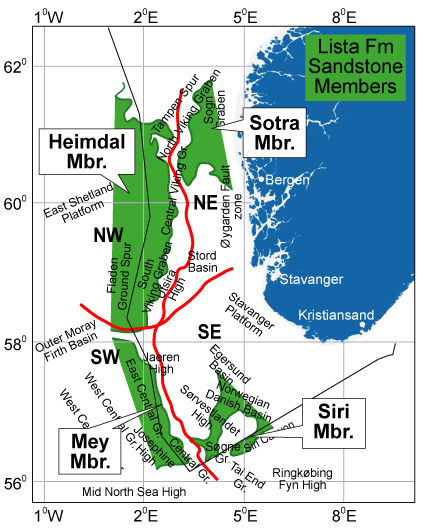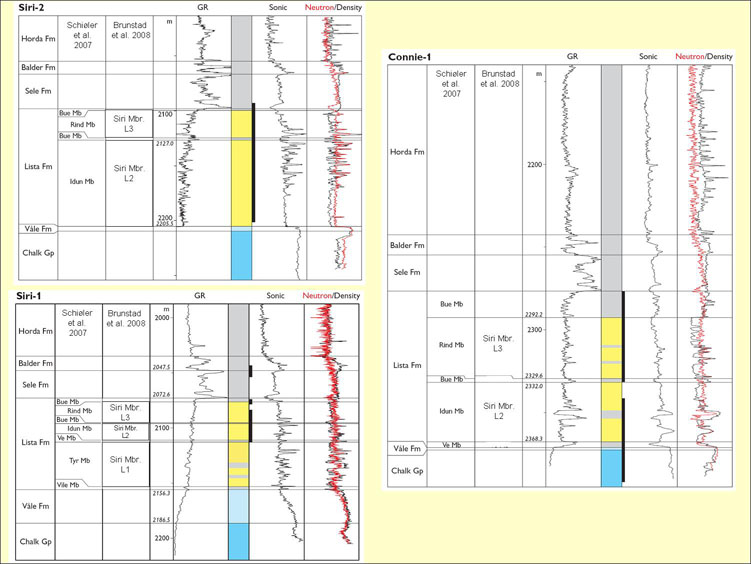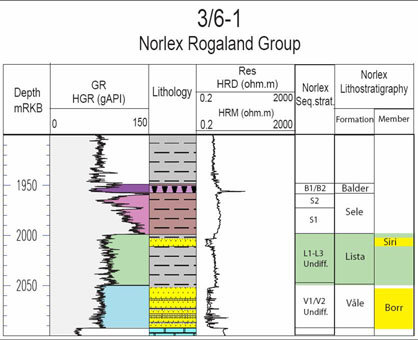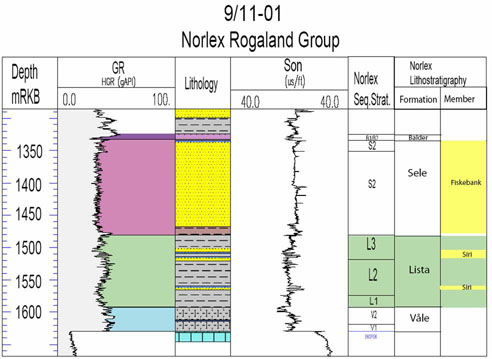Siri Member
updated to follow: Stratigraphic Guide to the Rogaland Group, Norwegian North Sea. Harald Brunstad, Felix M. Gradstein, Jan Erik Lie, Øyvind Hammer, Dirk Munsterman, Gabi Ogg, and Michelle Hollerbach. Newsletter on Stratigraphy, vol 46/2 pp137-286, 2013.
Rogaland Group, Lista Formation
Unit definition
The Siri Member is attributed to the intra Lista Formation
sandstones in subarea SE in
Figs. 1. While some authors split the intra Lista Formation sandstones of the
Siri canyon area and the southern parts of the Norwegian Danish Basin into three
separate members (Schiøler et al, 2007), we choose to give all intra Lista Formation
sandstones a common name: the Siri Member, a practice that has formerly been used also
in other studies, e.g. by Ahmadi et al. (2003) in the Millennium Atlas.
 Fig 1: Location map of the Members of the Lista Formation.
Fig 1: Location map of the Members of the Lista Formation. |
Name
It is unclear who defined the name first, but it was used by Ahmadi et al. (2003) in the
Millennium Atlas.
Derivatio nominis
The Siri Member is named after the Paleocene Siri Field, which contains intra Lista sandstones.
Type well
Danish well DK Siri-2, 2205.5-2127 mRKB and 2124-2100 mRKB. Coordinates N 56°29'40.53",
E 04°52'13.26" (Fig. 87). Cores 2092-2200.3 mRKB.

Fig. 87. Well Composite logs wells DK Siri-2 and Connie-1. Position of the Siri
Member is outlined in the stratigraphic column to the left. Modified from Schiøler et
al. 2007 to fit definitions made in the current revised nomenclature for the Norwegian
North Sea (this paper).
|
Reference wells (this study)
Connie-1 (Fig. 87): Depth 2368.3-2292.2m RKB. Coordinates 56°24'28,34" N, 04°42'30,36"
E. Cores 2273-2389.6m RKB.
Norwegian well 3/6-1 (New). Depth 2004-2011 mRKB. Coordinates 56°35'00.14" N, 4°53'30.35" E. Cores
(Fig. 88).
Norwegian well 9/11-1 (New, Fig. 89). Depth 1499-1515 and 1559-1567 mRKB. Coordinates 57°0'41.40" N,
4°31'40.60" E. No cores.

Fig. 88. Well 3/6-1 Composite log Rogaland Group. Stratigraphic position of the Siri
Member is outlined in stratigraphic column to the right.
|

Fig. 89. Well 9/11-1 Composite log Rogaland Group. Stratigraphic position of the Siri
Member is outlined in the stratigraphic column to the right.
|
Composition
The Siri Member is characterized by thick beds of olive-green to greenish grey. The
sandstones of the main sand bodies are in general very fine to fine-grained, very well
sorted and remarkably clean (<0.1% detrital clay). Sand grains are quartz dominated with
a high percentage of glauconite grains (15-20%), giving a greenish grey colour.
Glauconite grains are found as rounded pellets of same grain size as quartz grain.
Angular chalk and claystone clasts occur locally in the sandstones. The sandstones are
partly calcite cemented. Intrusive sandstones are common, in particular towards the top
of the Member where they may be several meters thick (Schiøler et al. 2007, Hamberg et
al., 2005).
In cores, sandstones of the Siri Member are often observed as generally massive,
homogenous and with few structures. Faint deformed lamination and dish and pillar
structures are rather common, and witness post sedimentary water movement in the
sediments. There are few signs of primary sedimentary structures in the sandstones,
although a few examples of faint cross bedding seem to occur.
Sandstone intrusions are frequently found associated with the upper boundary of
sandstones bodies, often with an abundance of angular and tabular mudstone clasts
(Hamberg et al., 2005).
Norwegian sector wells have penetrated only thin layers of the Siri Member. The sand
layers are very fine grained, micaceous and glauconitic compared to the better developed
sands described from cores in the Danish wells of the Siri Canyon.
Wireline log characterization
The sandstones have a high content of glauconite that increases their natural
radioactivity. This sometimes makes it difficult to distinguish Siri Member sandstones
from the mudstones of the Lista Formation based on gamma logs, and their identification
must rely on other logs such as density, neutron and resistivity logs.
Upper boundary
Where the Lista Formation shales overlie the Siri Member, the boundary is usually characterised by higher gamma-ray readings and lower velocity upwards into the Lista Formation.
Lower boundary
The Siri Member overlies the Lista and in places the Våle
Formation, and the boundary is
characterised by lower gamma readings and increased velocity upwards from the Lista and
Våle Formation below.
Thickness
The Siri Member is 78 m in DK Well Siri-2 and 72 m in DK Well Connie-1 (Fig 87).
Seismic characterization
Fig. 90 shows a seismic line example of the Siri Member through well Siri-2. From
seismic
mapping of the Lista Formation, thickness anomalies can be observed that have an
elongated shape, and a lenticular to mounded shape in seismic cross sections. This
thickening usually coincides with the presence of thick sand bodies of the Siri Member
in the area along the Norwegian Danish border and the Siri Canyon.

Fig. 90. Seismic section crossing the Siri Canyon and the Siri Discovery. Interval with
presence of Siri Member is outlined.
|
Age
Late Middle to Late Paleocene (Late Selandian and Early Thanetian)
Biostratigraphy
The Siri Member is embedded in the Lista Formation and is
limited by the
biostratigraphic boundary of the Lista Formation. For biostratigraphic details see
Lista Formation.
Correlation and subdivision
The Siri Member is further subdivided into Siri L1, Siri L2 and Siri L3 sub-members,
corresponding to the three Lista L1, L2 and L3 Sub-Members, equivalents to the Tyr (L1),
Idun (L2) and Rind (L3) Members of Schiøler et al. 2007.
Geographic distribution
The Siri Member is deposited across most of the central parts of the Siri Canyon, but
seems to stop just before it reaches the southern parts of the Søgne Graben. However,
some minor tongues of the Siri Member seem to reach into the northern parts of the Søgne
Graben, and into the Gyda Area further Northwest (Fig. 72).
Depositional environment
The Siri Member was deposited by gravitational flow in sand-rich basin-floor to
toe-of-slope fans systems. These deposits lie in front of the shallow marine and shelf
slope progradation of the Fiskebank Member. The gravity flow
mechanism was probably a
combination of high-density sandy turbidity currents and sandy debris flow. The high
glauconitic content suggests that there was a significant contribution of shelf sands.


 Fig 1: Location map of the Members of the Lista Formation.
Fig 1: Location map of the Members of the Lista Formation.

